April 22, 2024–Saigon (Ho Chi Minh City), Vietnam
- mlchad147
- Apr 23, 2024
- 8 min read

Rooftop of the Rex Hotel.
Vietnam continues to surprise, and today’s first one came before we even docked. I was up early, sitting in a lounge watching out the window as we sailed into Vung Tau, when I saw what looked like a smaller version of Rio’s Christ the King statue atop a high hill near the port entrance. Some quick research confirmed that I was not mistaken. It is indeed a statue of Jesus, the largest in Asia, and reflects a fact I was completely unaware of. This part of Vietnam has a strong Christian heritage, largely due to the efforts of the French, and fully seven percent of the population is Catholic. How about that.
Saigon isn’t on the coast, but is 45 miles inland, 65 by car, so we docked at Vung Tau and bused to the city, a trip that took 90 minutes due to heavy traffic, much of it trucks. Indeed, if the volume of truck traffic is any indication Saigon is doing just fine economically. On the way to the city we passed a constant string of small businesses, but we also passed several rice paddies, a cathedral-like Catholic church, and some of the densest jungle I have ever seen.
As we neared the city it was clear that Saigon is a major metropolis. The population of the city proper is 9.3 million, but the greater metropolitan area is home to 21 million residents, and make no mistake, that’s a lot of people. One of my first observations as we arrived this morning was that most of those people own a motorbike and were out on the streets with them. We’ve seen a lot of motorbikes in other cities in Asia, but nothing compared to the numbers here. To give you an idea of what motorbike traffic is like here, our guide said motorbike driving in Saigon is a three step process. First is overcoming the pure fear that accompanies it. Second is developing enough confidence to get out into the craziness, and third is learning how the flow of it works.
Perceptive readers may have noted that I keep referring to the city as Saigon, although its name was officially changed to Ho Chi Minh City at the end of the Vietnam War in 1975. The reason is simple—most residents couldn’t care less what the northerners call it. To them it’s Saigon. Without going into the rabbit hole of this nation’s complicated history, I’ll just point out that the north and south are culturally distinct, and dividing them into two countries after the French left actually made some sense. Ho Chi Minh had other ideas, and the rest, as they say, is history.
Saigon is a vibrant, high energy city, and if not for the omnipresent red flags you’d never know you were in a communist country. Free enterprise is unrestrained here, and capitalism is clearly the order of the day. Predictably, the twenty years of the north’s attempt to transition the south to communism after the war were an unmitigated disaster, and resulted the wise decision to scrap it and open the country to free market capitalism. That genie is fully out of the bottle now, and a reversal at this point seems unimaginable to me. Our guide said that VC no longer stands for Viet Cong, but now stands for Vietnamese Capitalist. In fact, Vietnam is more open than I even imagined, to the point that Google, Facebook, WhatsApp, and a host of other social media applications are freely accessible by the population. Make no mistake, you can get in trouble for agitating against the government, but other than that it’s a surprisingly free country.
Before stopping anywhere we made a bit of a driving tour of some city highlights, and the one that stood out for me was Chinatown. We’ve walked through a few really busy Chinatowns on this cruise, and all I can say about this one is that it can hold its own with any of them. Add heavy motorbike traffic to the usual narrow streets, vibrant colors, endless shops selling everything imaginable and huge crowds on foot and you’ve got Saigon’s Chinatown. Sensory overload would not be an overstatement. I would love to have stopped and plunged into it, but there wasn’t time on our itinerary.
Our actual first stop of the day was at Notre Dame Cathedral and the Central Post Office, two great old buildings constructed by the French when they controlled the country. We couldn’t see much of the Cathedral, because it was covered in scaffolding due to major renovation work, but the Central Post Office was open and was a beehive of activity. The interior is gorgeous, beautiful in a classic sort of way without being overdone. I loved it. It’s probably the largest post office I’ve ever been in, and it combines the usual postal services with a shopping and souvenir center. We bought a postcard from one of the vendors, filled it out and took it over to the postal counter, bought a stamp and mailed it home. Talk about one stop shopping.
I mentioned that the Cathedral and Central Post Office were built by the French, and that’s worth a comment. The locals are somewhat ambivalent about the French. They had to go to war with them to achieve their independence, but they also respect the fact that the French put a lot of money into improving the country, especially in the area of infrastructure, helping to modernize Vietnam. It’s an interesting dichotomy.
We next made our way to the five star Rex Hotel, where the US military used the rooftop garden to hold daily 5:00 pm briefings for the press on the state of the war. The press apparently began calling them the 5:00 funnies, reflecting their assessment that the briefings were unrealistically optimistic. History buff that I am, I had to go up there to check it out. We also got a look at the French-built City Hall, which is now fronted by a large plaza dominated by a statue of Ho Chi Minh. And here’s a trivia fact. Contrary to popular belief, the famous 1975 photo showing a rooftop helicopter evacuating pro-US Vietnamese as the city fell wasn’t taken of the Rex Hotel or the US Embassy, but was at a CIA safe house some distance away.
Moving along, by now it was lunchtime, and we were turned loose for 90 minutes in one of Saigon’s top shopping districts to shop and eat. Some of our group stayed at the Rex Hotel’s rooftop restaurant, where a couple later told us they paid $80 for a lovely meal. We, on the other hand, walked over to a nearby shopping mall, where three or four floors underground there was a massive food court. Michele and I picked a nice sit-down restaurant where we had an excellent meal for a combined total of less than eight dollars. At home I pay more than that for a burger, fries and a Coke at a fast food restaurant. The dollar is really strong all across Asia, and unless you’re having a rooftop meal at the five star Rex money goes a long way here. On our way back to the bus after lunch I bought a hat from a street vendor for two dollars. If you can stand the incredibly oppressive heat and humidity (I can’t, as today’s experience made clear) you can live here very inexpensively. By the way, the exchange rate here is around 25,000 dong to the dollar. Exchange $100 US into dong and you’re a millionaire.
We had one more destination on the itinerary before we had to make the 90 minute trip back to the port, and it was a fascinating one. South Vietnam’s former presidential palace is now called the Reunification Palace, and is open to the public as a museum. Almost all of it was left exactly as it was at the end of the war, including formal areas, living quarters, war rooms with maps still on the walls, and even the underground bomb shelter. I really did feel like I was walking through history as we toured the palace, and the only downside was the incredible heat and humidity. None of the building is air conditioned, and the sauna-like atmosphere was a little distracting. Michele and I joked that we’ve been drier in swimming pools. Still, it was a great visit and I’m really glad it was on our itinerary.
A final thought about Vietnam. Our guide told us his father died in 1973 fighting for the South when he was only three. He also said that after the war the North Vietnamese dug up the public cemeteries for South Vietnamese war dead and made the families rebury the bodies elsewhere. There’s a lot of underlying resentment towards the north here in Saigon, but it’s not apparent on the surface, both because of the of risk of suppression by the communist government and the fact that at the end of the day the South won a lot of what they were fighting for, a vibrant free market economy. Their country is certainly more open than China, and we could feel the difference from the moment we passed through immigration on our way in. I liked Vietnam, and if not for the insufferably hot and humid weather I’d put it on my list of places I’d like to visit again.
That’s all for now. We’re on our way to Singapore, an island with a fascinating history of its own, and I can’t wait to get there. Who knows, maybe I’ll even get to visit the Raffles Hotel, where the Singapore Sling was invented. I’ll be back afterwards to tell you all about it, so stay tuned.

The largest statue of Jesus in Asia welcomed us as we sailed into Vung Tau.

We saw lots of rice paddies on our way in to Saigon.

Another common sight in the more rural areas.

Another common sight. Unlike in Japan, there was a lot of trash along the roadways.

Michele took this neat photo of a motorbike, with the 81 floor Landmark Tower in the background.
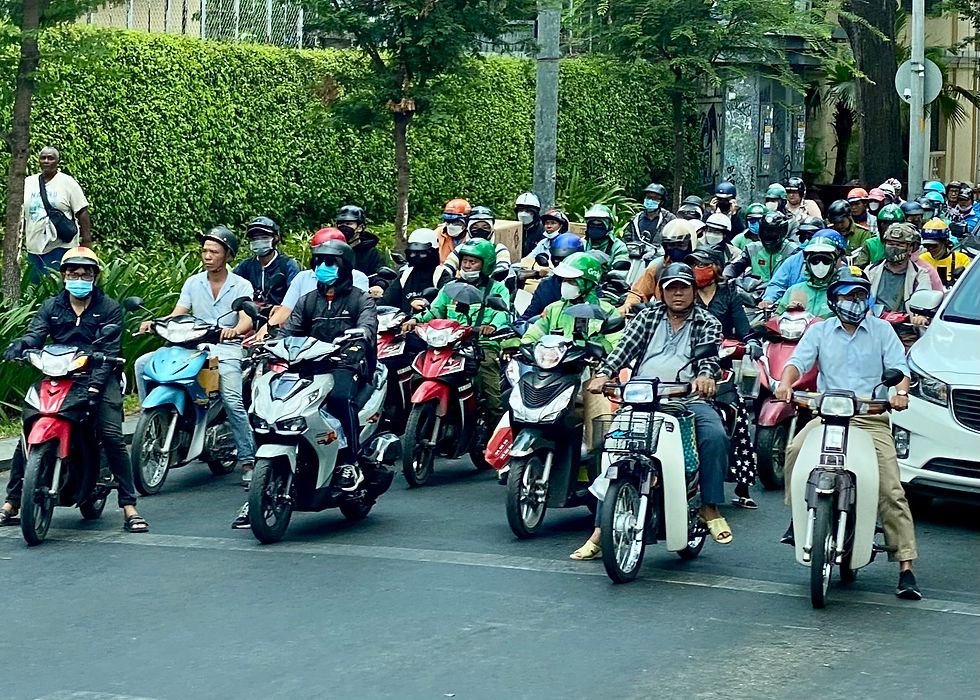
On your mark…get set…

And they’re off!
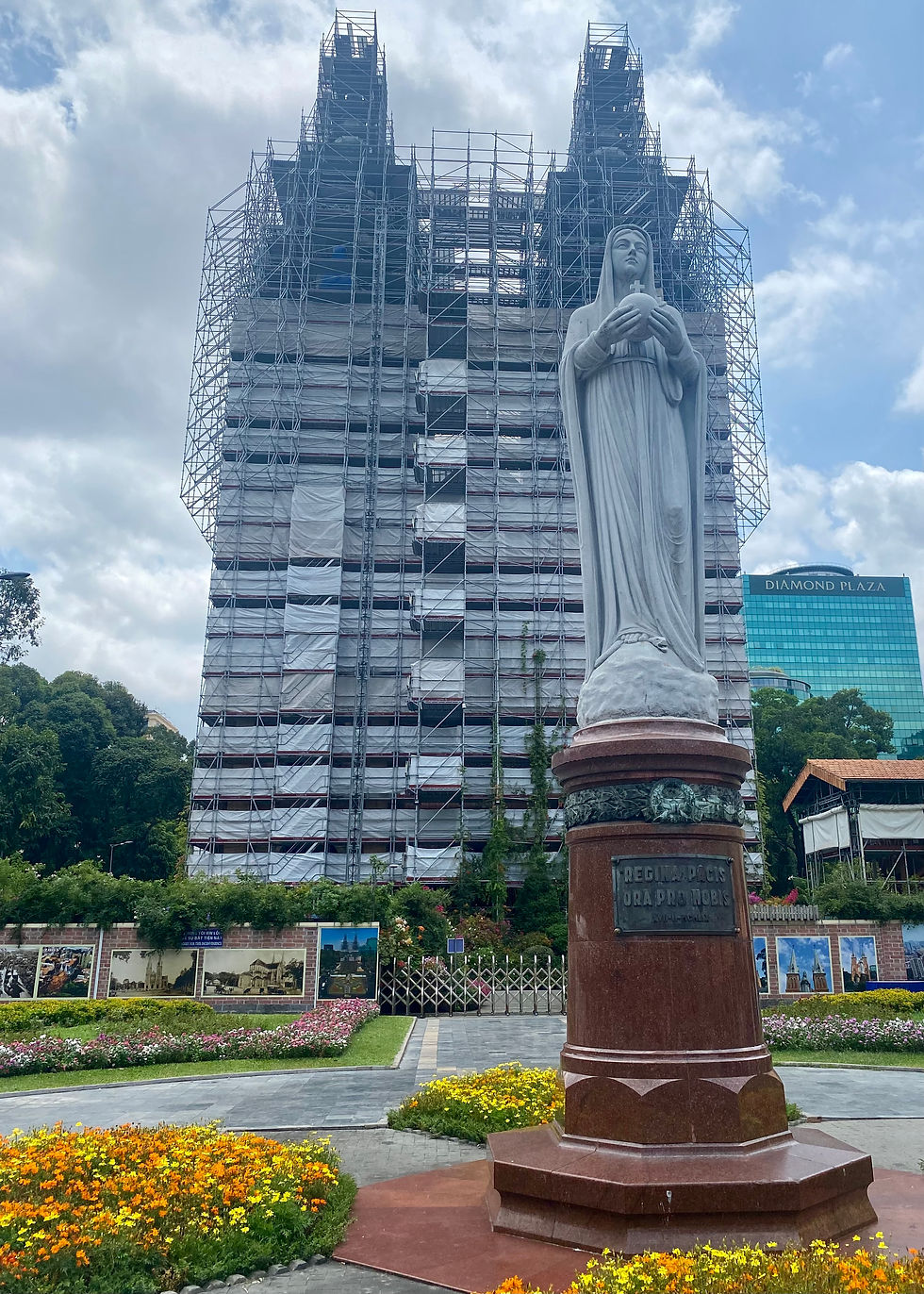
The front of the Cathedral was covered in scaffolding. Too bad, I would have enjoyed seeing it.

Michele did get a shot of the back of the Cathedral. Best we could do.

The Central Post Office is a wonderful building, constructed by the French during their occupation.

The interior of the Central Post Office is a delight, part shopping area and part postal operation.

The Opera House is yet another grand old French building.

City Hall, another beautiful French building, in the background. These days it’s Ho Chi Minh who’s inviting you in from the courtyard.

The five star Rex Hotel, where the US military used to hold press briefings on the roof.

The former South Vietnamese presidential palace is now a museum, renamed the Reunification Palace.

There are two North Vietnamese tanks on display outside the Palace.
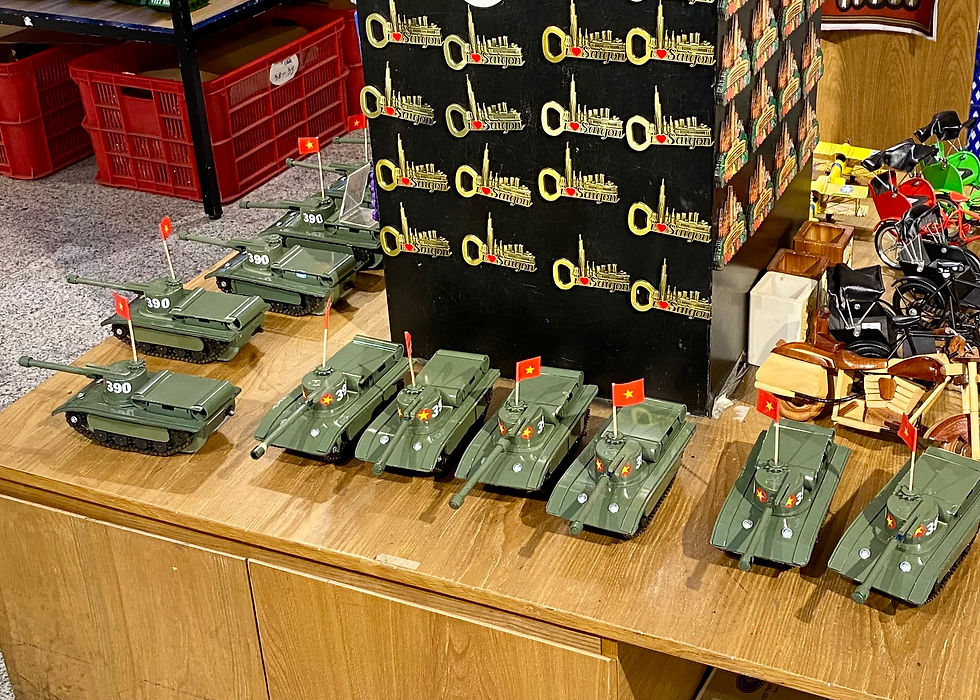
And you can buy toy North Vietnamese tanks in the Palace gift shop.

Conference room in the Palace. Everything is as it was during the Vietnam War.
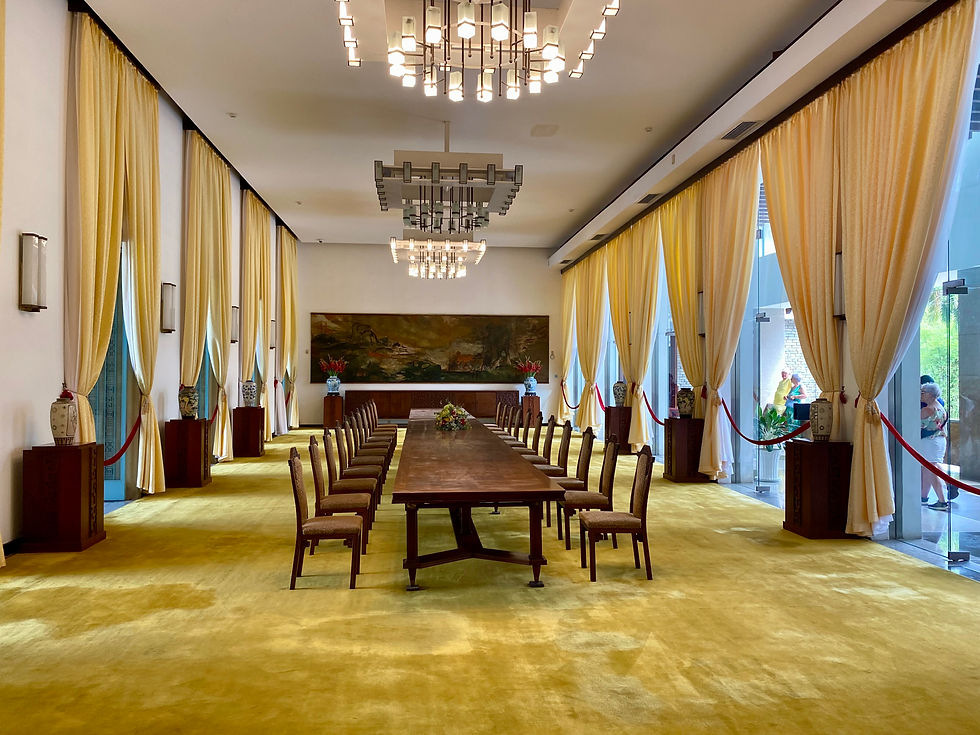
Formal dining room.

Large receptions were held in this room.

Meeting room.
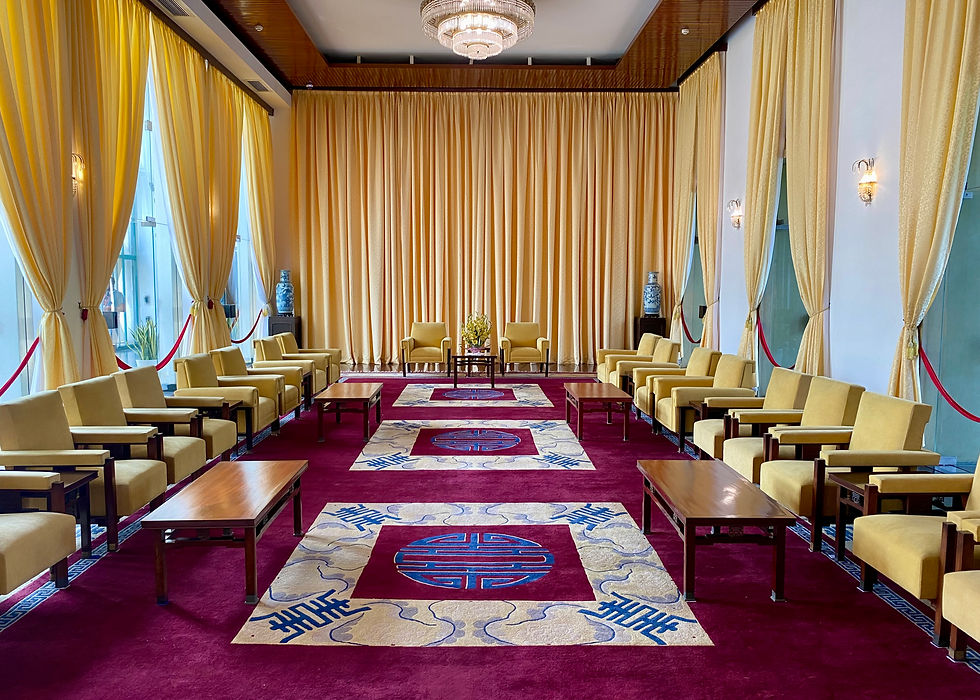
Another meeting room.

President’s formal office.

To me some of the more interesting rooms were in the basement. This was a war room, with the maps still on the wall.

1975 communications equipment.

Communications room.
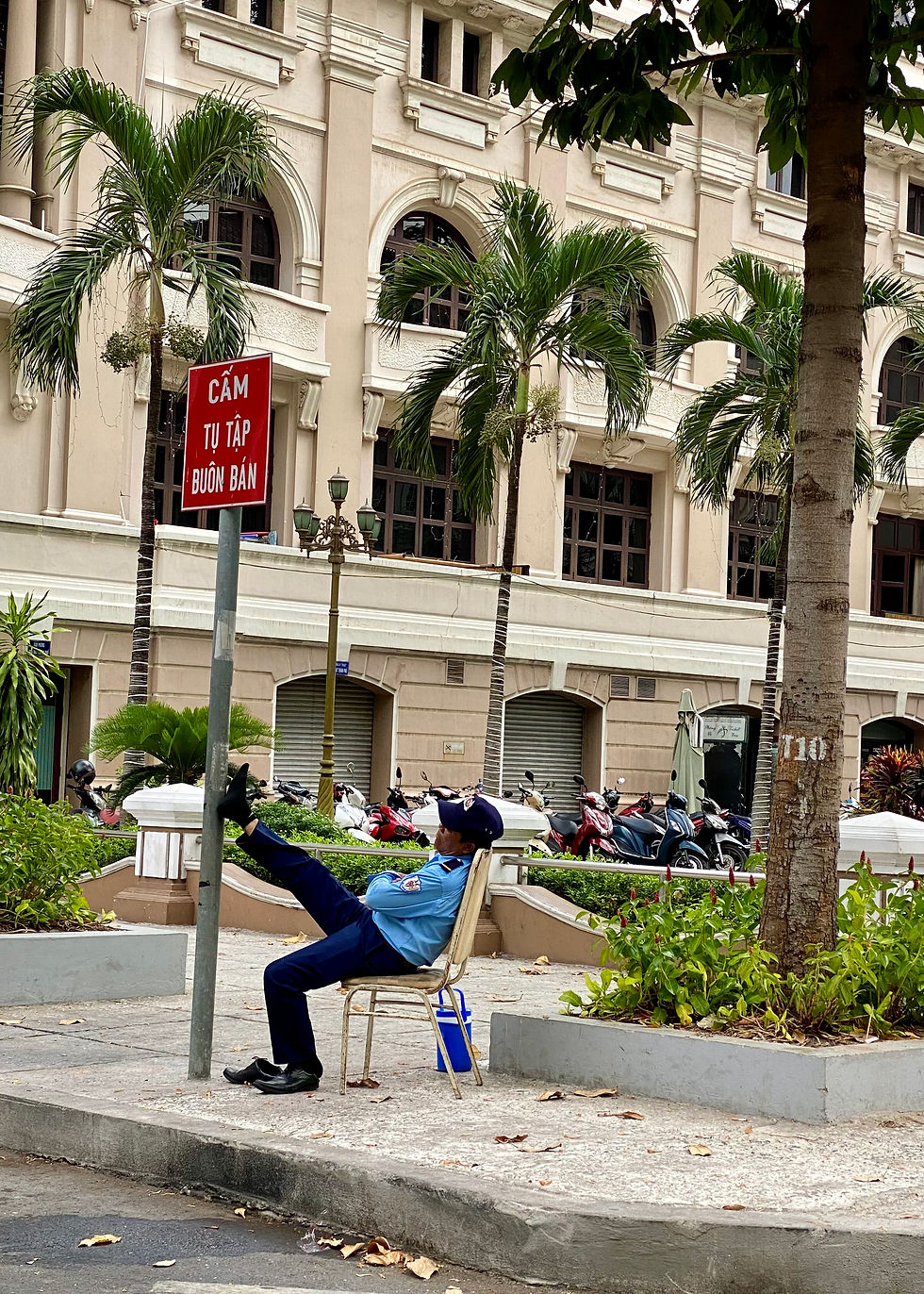
I thought this would be a fun one to end on. Traffic cop hard at work in downtown Saigon.


